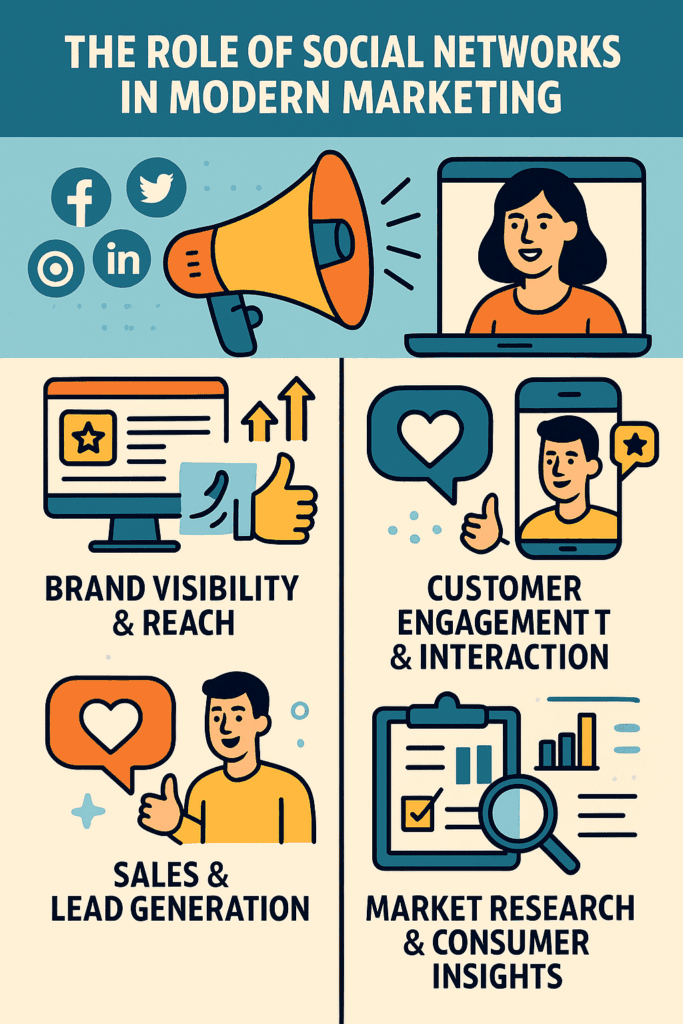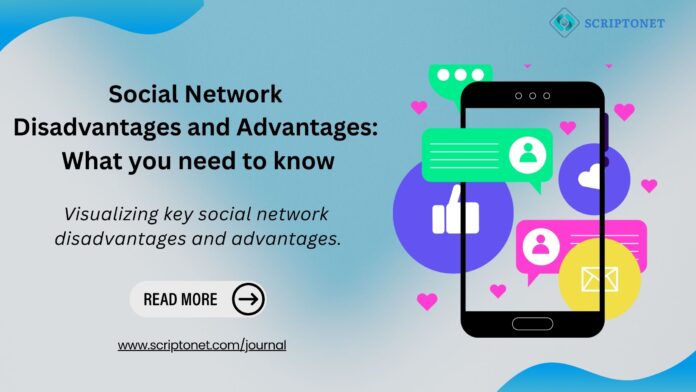Introduction
Social networks are becoming an essential component of contemporary marketing plans. Social Network disadvantages and advantages are important to be discussed, as such networks give companies a strong platform to engage with consumers, advertise goods & foster customer loyalty. Social networks are fundamentally online communities where people & organizations exchange information, communicate & have deep discussions. Emerging channels & well-known platforms like Facebook, Instagram, Twitter & LinkedIn provide marketers with special chances to connect with a range of demographics, develop focused campaigns & acquire insightful data about their customers.
As digital landscapes change, social networks have shown themselves to be successful at increasing sales & improving customer relationships in addition to being an affordable advertising option. Social network marketing does have many advantages, but it also has drawbacks, such as the potential for harm to a brand’s reputation, the requirement for constant maintenance & the unpredictable nature of the platform algorithm. As a result, social networks are becoming an indispensable part of modern marketing plans because they give businesses an effective platform to connect with consumers, promote goods & foster customer loyalty.
The Role of Social Networks in Modern Marketing
Unlike traditional marketing channels, social media offers an interactive platform where brands can engage directly with their audiences, obtain real-time feedback & foster lasting relationships. Social networks significantly influence modern marketing, transforming how businesses engage with consumers, build connections & drive sales. Their impact on marketing is multifaceted, covering customer engagement, sales generation, brand visibility & market insights.

- Brand Visibility & Reach: Businesses have an unmatched chance to boost awareness thanks to social networks. Platforms like Facebook, Instagram, Twitter & LinkedIn, which have billions of active users globally, allow marketers to rapidly reach wide-ranging &sizable audiences. Social media algorithms contribute to organic reach by amplifying information through likes, comments & shares. Paid advertising features also enable brands to reach a wider audience than just their followers, guaranteeing that the right people see their messages. In addition to increasing recognition, this broad reach helps companies reach potential clients who might not be reachable through conventional marketing channels & break into new markets.
- Customer Engagement & Interaction: Encouraging direct & significant communication between brands & customers is one of social networks’ most notable marketing functions. Posts, stories, videos, live sessions & interactive materials like surveys & quizzes are all ways that businesses can interact with their audience. Social media gives firms a special platform to express their individuality, answer consumer questions & get feedback. Higher consumer happiness & loyalty are a result of this two-way connection, which also humanizes the business & fosters trust. Engaged consumers are more inclined to spread the word about a business by telling their networks about their great experiences.
- Sales & Lead Generation: Businesses may now directly create leads & drive sales through platforms as social networks become more integrated with e-commerce capabilities. Transactions are made easy with features like “Shop Now” buttons, product tags & in-app purchases. Social media has transformed from a promotional tool to a full-fledged sales channel thanks to platforms like Facebook Marketplace, Instagram Shopping & Pinterest Buyable Pins. Lead-generation advertisements on social media sites like Facebook & LinkedIn also assist companies in gathering useful client information so they may develop prospective leads with focused advertising campaigns.
- Market research & consumer insights: Social media platforms are abundant data sources that give companies knowledge about the habits, inclinations & patterns of their customers. To learn more about their audience, marketers might use polls, social media discussion monitoring & engagement metrics analysis. Brands can improve their marketing strategy by using tools like Meta Business Suite, LinkedIn Insights & Twitter Analytics, which offer useful analytics. Brands can modify their goods, services & messaging to meet consumer needs by paying attention to what they have to say. Furthermore, social media competition monitoring can give companies a competitive edge, enabling them to spot opportunities & maintain their market leadership.
- Influencer Marketing & Collaborations: Another important facet of social network marketing is influencer marketing. Businesses can reach niche audiences with greater engagement rates by working with influencers who share their values. Influencers serve as reliable spokespersons, providing sincere recommendations that can greatly increase the legitimacy of a company. These collaborations are made possible by social media platforms, which offer data to gauge the effectiveness of campaigns & influencer marketplaces.
Advantages of Social Networks in Marketing
- Expansive Brand Visibility & Global Reach: The capacity of social networks to increase awareness globally is among their most important benefits. Platforms such as Facebook, Instagram, Twitter & TikTok, which have billions of active users, give marketers access to a wide range of demographics & geographic areas. Social media, as opposed to traditional marketing, provides both sponsored & organic ways to increase reach. Without incurring significant expenses, user-generated content, shares & viral material can dramatically raise a brand’s visibility. Additionally, because social media is shareable, material may spread swiftly, giving brands a chance to become extremely visible through viral challenges or trends.
- Cost-effective Marketing & Advertising: Compared to more conventional advertising channels like print, radio or television, social media marketing is more affordable. Posting, interacting with followers & using analytics are just a few of the many free social networking tools available. Platforms like Meta Ads, LinkedIn Ads & Twitter Ads give firms accurate targeting capabilities & varied budget alternatives even when they invest in paid advertising. This affordability is especially advantageous for small businesses, as it enables them to compete with larger brands through planned & well-designed social media campaigns.
- Advanced Targeting & Personalization: Advanced Targeting & Personalization capabilities that enable them to connect with certain audiences based on their demographics, hobbies, habits & even life events. Platforms evaluate user data using algorithms, allowing for highly customized marketing campaigns. By presenting the appropriate message to the appropriate audience at the appropriate moment, personalization not only makes advertisements more relevant but also raises the likelihood that they will be converted.
- Direct Engagement & Customer Relationship Building: Social networks allow for real-time communication between businesses & customers, which sets them apart from traditional marketing platforms. Through comments, direct messages & interactive postings, businesses may immediately address consumer complaints, take part in debates & answer customer questions. Trust is developed & a feeling of community is fostered by this direct interaction. Additionally, organizations may increase consumer loyalty by humanizing themselves through storytelling, displaying behind-the-scenes videos or adopting a conversational tone. Brands & advocates are more likely to be engaged consumers who spread the news about the company on social media & through word-of-mouth.
- Real-time analytics & performance monitoring: Social media platforms give companies access to comprehensive data that aids in gauging the success of advertising initiatives. Metrics like reach, engagement, click-through rates & conversion statistics are provided by tools like Instagram Insights, Twitter Analytics & LinkedIn Analytics. Marketers may quickly modify campaigns by using these analytics to monitor what works & what doesn’t. One major benefit is the ability to assess performance in real-time, which enhances marketing ROI & facilitates data-driven decision-making.
Disadvantages of Social Networks in Marketing
- Negative Comments & PR Risks: Due to social media’s open nature, unfavorable remarks, criticism or false information may proliferate swiftly & harm a brand’s reputation. Responses that are poorly managed can turn into major public relations disasters. Issues might worsen if criticism is handled poorly. Responses that are too defensive, contemptuous or inconsistent might incite public indignation & result in a full-blown public relations disaster. Social media backlash is one example of this when companies have handled delicate subjects poorly, failed to provide sincere apologies or seemed out of touch with public opinion.
- Time-consuming Management: Continuous content production, interaction & monitoring are necessary for consistent social media management. It might be difficult to keep up a significant presence without committed resources. Maintaining an active & interesting online presence is essential for effective social media marketing. To draw in customers, brands must constantly provide original, timely & eye-catching content. This entails organizing, creating, composing & scheduling content for a variety of channels, each with its own audience expectations & content type.
- Platform Dependency & Algorithm Updates: Social media companies often modify their algorithms, which affects organic exposure & reach. Relying too much on one platform also puts you in danger of losing audience access if the popularity or policy changes. Brands should take a diverse strategy to reduce these risks by creating owned channels, including websites, email lists & community forums, as well as by remaining present on a variety of platforms. This tactic guarantees that companies continue to communicate with their audience consistently & are resistant to platform-specific changes.
- Increasing Advertising Costs: As more brands compete for attention, ad costs on social platforms are rising. This can strain marketing budgets, particularly for small businesses aiming to maintain visibility. This increase in advertising expenses can be a major problem for small enterprises with tight finances. Smaller companies may find it difficult to be noticed, in contrast to larger brands that can afford to outbid rivals & maintain a high ad frequency. To attain a significant Return on Investment (ROI) without going over budget, they might need to carefully manage their spending. Businesses may focus on organic growth methods, use low-cost channels, improve audience targeting to cut down on unnecessary expenditure, & produce highly engaging content to increase organic reach to handle escalating ad expenses. Additionally, using fewer resources to generate greater outcomes may be facilitated by routinely testing & adjusting advertising strategies.
- Brand Safety & Control Issues: Social networks can expose brands to inappropriate content, fake accounts & uncontrollable public narratives, which can harm brands’ image & credibility. Because they may disseminate incorrect information, write deceptive reviews or commit fraud under the pretense of a genuine brand, fake accounts & bots are equally dangerous. Such actions have the potential to damage trust, mislead customers, and damage credibility. Furthermore, social media public narratives are frequently erratic. The tone of internet conversations may be swiftly changed by social movements, trendy hashtags or viral content. A may face criticism & bad press if it inadvertently gets engaged in contentious subjects or handles delicate subjects improperly. Proactive steps are necessary to maintain brand safety, such as establishing precise ad placement guidelines, keeping an eye on brand mentions & acting quickly to address any possible problems.
Strategies for Effective Social Network Marketing
- Content Strategy Development: Information strategy development is the process of producing interesting, pertinent & dependable information.
- Techniques for Engagement & Interaction: Using live sessions, polls & interactive materials.
- Using Tools & Analytics: Tracking performance using tools such as Google Analytics & Meta Business Suite.
- Crisis Management Plans: Getting ready for criticism & possible public relations difficulties.
- Leveraging New Technologies: Adopting trends in social commerce, AI, AR & VR.
Successful Use of Social Networks in Marketing
Coca-Cola’s “Share a Coke” Campaign
Coca-Cola started the “Share a Coke” campaign by using well-known names on bottles in place of its distinctive logo. Customers were urged by the firm to use the hashtag #ShareaCoke when posting pictures of their customized Coke bottles on social media. Customers actively created & shared content as a result of the campaign, which greatly increased user engagement. Coca-Cola’s sales & promotions on various platforms increased significantly, proving the effectiveness of social media interaction & user-generated content. Social media amplification, together with personalized content, may increase awareness & encourage active consumer interaction.
Mishaps of Social Networks in Marketing:
Pepsi’s 2017 Kendall Jenner Ad Controversy
In a Pepsi commercial, Kendall Jenner is shown participating in a demonstration & giving a police officer a can of Pepsi. The advertisement received criticism for being tone-deaf & trivializing social justice movements. Due to the rapid & severe social media criticism, Pepsi was forced to remove the advertisements & apologize. As an example of how rapidly public opinion can shift on social media, the brand’s reputation suffered. Sensitive subjects need to be handled by brands carefully & authentically. Neglecting cultural or social circumstances can seriously harm one’s reputation.
Conclusion
In conclusion, businesses may interact with their consumers, increase brand awareness & propel marketing success with the help of social networks. Increased reach, affordable advertising, direct consumer interaction & insightful analytics are all benefits of social media marketing. Influencer collaborations, user-generated content & trends may all be used by brands to build genuine relationships & encourage brand loyalty.
But there are drawbacks to these advantages. Consistent management, inventiveness & flexibility in response to platform modifications are necessary for social media marketing. It’s important to carefully manage risks like bad reviews, PR disasters, growing advertising expenses & safety concerns. A brand’s reputation might suffer from an over-reliance on particular channels or from improperly managing public narratives.
Frequently Asked Questions (FAQ)
What are the primary benefits of marketing through social networks?
Increased brand awareness, targeted advertising, real-time customer interaction, affordable promotions & access to insightful data are just a few benefits that social networks provide. They also help marketers to form communities, use user-generated content & create viral marketing possibilities.
What are the potential disadvantages of social media marketing?
Challenges include managing negative feedback, handling PR crises, increasing advertising costs & maintaining brand safety. Brands may also struggle with the time & resources needed for constant content generation & adjusting to frequent algorithm changes on social platforms.
What are some effective strategies for brand safety on social media?
Brands should have a crisis management plan, monitor social media mentions, set ad placement controls, use brand safety tools like Integral Ad Science or DoubleVerify & regularly review influencer partnerships. They should also maintain a consistent, genuine brand voice.
What typical errors should one steer clear of while using social media for marketing?
Avoid overly promotional content, ignoring customer feedback, lacking a consistent posting schedule, failing to adapt to platform trends & not monitoring Brand mentions. Brands should also avoid engaging in controversial topics without a clear strategy.
How can businesses use social media to efficiently handle a crisis?
Take prompt action, admit the problem, respond honestly & clearly & accept responsibility if necessary. Having a prepared crisis management plan, including designated spokespersons & predefined response strategies, can help manage the situation effectively.


